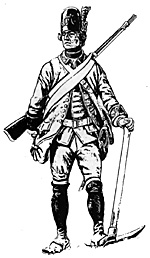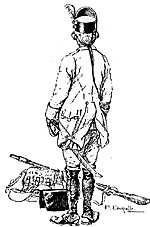 [Editor: the following article appeared in an issue of Military Modelling, a copy of which was sent to me by Mark Henry. Unfortunately I do not have the date, volume or issue number of the original article.]
[Editor: the following article appeared in an issue of Military Modelling, a copy of which was sent to me by Mark Henry. Unfortunately I do not have the date, volume or issue number of the original article.]
Apart from material and social factors, elements of war technology played a decisive role during the reorganization of Maria Theresa's army. In the wars of Charles VI an increasing technicalization of warfare had already come into prominence. In the First Silesian War, Prince Joseph Wenzel Liechtenstein had realized the worth of modern artillery and, on the other hand, the deficiency of the Austrian pieces. In the following years he brought about a basic reorganization of this arm, which guaranteed from then on a reputation throughout most of Europe.
The different technical corps -- the engineer, pioneer, pontonier and military bridging units -- also gained more importance. One could almost speak of a rising tactic of combined arms. In the Seven Years War, however, it was evident that the performance of the Austrian military engineers was not at its best in spite of better training. One important reason for the bad performance of the military engineers was the activity of unskilled soldier-laborers in the trenches. Thus in the assault of Schweidnitz in 1757, soldiers of the Walloon regiments were used because they had some experience in digging trenches from their service in foreign armies.
Finally, the French officer Jean Baptist Gribeauval de Vaquette, who had come from French service and had joined the Austrian army in 1758, suggested in Dresden, in 1760, the creation of an Austrian Sapper Corps for siege warfare.
In April 1760 the Sapper Corps was duly set on foot and put under the authority of General-Genie-Directeur Carl Alex von Lothringen. The immediate command was exercised by the Obristwachtmeister Johann von Bechard. The strength of the Sapper Corps was 186 men. The officers were interchangeable with those of the military engineers. The privates came from the infantry where each infantry regiment had to hand over four soldiers. One in every four soldiers was expected to be able to read and write and this man was then the candidate for the rank of a non-commissioned officer. All of the men were to be strong and able-bodied.
 A Sappeurmeister drew a monthly salary of (?) florins [Editor. This information was cut off in the photocopy of the article ] This non-commissioned officer had to be capable of reading and writing, of marking out a profile and surveying. In case of possible unfitness for military service the position of civil engineering secretary or a casern-supervisor was assigned to him.
A Sappeurmeister drew a monthly salary of (?) florins [Editor. This information was cut off in the photocopy of the article ] This non-commissioned officer had to be capable of reading and writing, of marking out a profile and surveying. In case of possible unfitness for military service the position of civil engineering secretary or a casern-supervisor was assigned to him.
In April 1760 the sappers were still clad in different, threadbare uniforms. Later on, the sapper uniform consisted of leather breeches, a pike-grey (hechtgrau) coat with turnback skirts and cuffs of carmine red. The leather cap was trimmed with yellow and had, at the front of the foreside, Maria Theresa's royal cypher. A red plume ornamented one side.
The sapper was armed with a light, short musket with a long bayonet and a 20 inche sabre. This cutting weapon could also be used as a saw; the back edge was toothed. The weight of the sabre was 1.5 kilograms. The pouch could hold 15 cartridges. The work equipment of each sapper company consisted of 50 pairs of pickaxes and shovels, 10 large strings (massschnure) with winches, 6 picks, 4 saws, 14 kettles and 42 bottles.
The Sapper Corps built up a good reputation very quickly. Because of its low strength it was called corpetto. In the last three years of the Seven Years War the Sapper Corps was in action during A of the sieges and defences of fortresses and firm positions. Included in these episodes were the taking of Glatz in 1760, the second capture of Schweidnitz in 1761, and during the 68 day-long defence of that fortress in 1762.
In this latter episode, 25 sappers under the command of captain Eghls were put into action. Ten sappers were killed, four were badly wounded. Captain Eghls received the Military Order of Maria Theresa. The commanding officer of the sappers - also a holder of the Order, had distinguished himself so much at Glatz in 1760, that he was chosen to bear the 33 captured colors in triumph to Vienna. Here, Bechard was promoted to a lieutenant-colonel. In all, three sapper officers received the Military Order of Maria Theresa - a remarkable honor for a corps of such size. The corps was united with the engineers and mineure in 1772.
Back to Seven Years War Asso. Journal Vol. X No. 3 Table of Contents
Back to Seven Years War Asso. Journal List of Issues
Back to Master Magazine List
© Copyright 1998 by James E. Purky
This article appears in MagWeb (Magazine Web) on the Internet World Wide Web.
Other military history articles and gaming articles are available at http://www.magweb.com